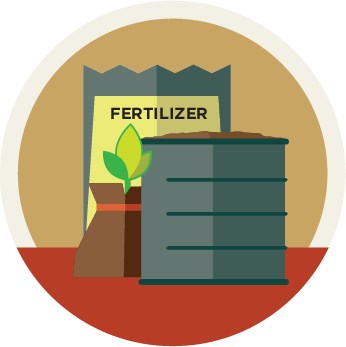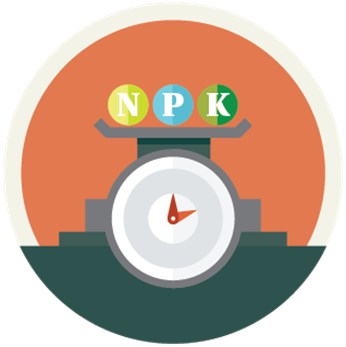


Keep nutrients where crops can use them.

Matches fertilizer type to crop needs.

Matches amount of fertilizer type crop needs.

Makes nutrients available when crops needs them.
The 4R nutrient stewardship principles are the same globally, but how they are used locally varies depending on field and site-specific characteristics such as soil, cropping system, management techniques, and climate. The scientific principles of the 4R framework include:
Ensure a balanced supply of essential nutrients, considering both naturally available sources and the characteristics of specific products, in plant available forms.
Assess and make decisions based on soil nutrient supply and plant demand.
Assess and make decisions based on the dynamics of crop uptake, soil supply, nutrient loss risks, and field operation logistics.
Address root-soil dynamics and nutrient movement, and manage spatial variability within the field to meet site-specific crop needs and limit potential losses from the field.
Properly managed fertilizers support cropping systems that provide economic, social, and environmental benefits. On the other hand, poorly managed nutrient applications can decrease profitability and increase nutrient losses, potentially degrading water and air.
4R nutrient stewardship requires the implementation of best management practices (BMPs) that optimize the efficiency of fertilizer use. The goal of fertilizer BMPs is to match nutrient supply with crop requirements and to minimize nutrient losses from fields. The selection of BMPs varies by location, and those chosen for a given farm are dependent on local soil and climatic conditions, crop, management conditions, and other site-specific factors.
Other agronomic and conservation practices, such as no-till farming and the use of cover crops, play a valuable role in supporting 4R nutrient stewardship. As a result, fertilizer BMPs are most effective when applied with other agronomic and conservation practices
Placing Fertilizer with Seed-Factors to consider when applying fertilizer with the seed:
Split Fert Application-Split applications target plant needs. Split applications of nitrogen help growers match crop requirements with nutrient supply, and can increase nitrogen efficiency by more effectively matching nutrient supply with plant needs.
Starter Fertilizer-With starter fertilizer, a little goes a long way. Starter fertilizers can be used as a strategy for managing within-field nutrient variability. Nutrients in starter fertilizer provide synergistic effects.
Soil pH and Plant Nutrients– Phosphorus (P) is the nutrient most directly affected by soil pH. Most ongoing crop production will gradually lower the soil pH. Iron deficiencies are best addressed by avoiding high pH soils altogether.
Soil Sampling– A precise soil analysis can result in more efficient fertilizer use. Most experts recommend annual testing. Attention to detail helps to ensure a successful soil sampling program • Trends are key to analyses and planning.
Grain Nutrient Analysis– How do new genetics affect nutrient content in grain? What is the best way to collect grain samples? Where can you find “book values” of nutrient removal rates?
Highs and Lows of Soil Test Potash- Factors that contribute to swings in K test results. Why it is better to take fewer soil samples with more cores than more samples with fewer cores when testing for K. Tips on how you can minimize variability.
Nitrogen Loss Pathways Flyer– Weather hinders perfect N management. Determine your most significant N-loss pathways. Focus on addressing those pathways with BMPs.
Sulfur is the 4th Major NutrientCrops having high N needs will usually also have high S needs. Several factors should be taken into account when making S fertilization decisions. There are several S fertilizer sources available.
Keep an Eye on Potassium– Regularly scheduled K applications are often a practical approach to managing soil test K variability. Suggestions for Monitoring K in the Soil-Crop System.
High-Quality Alfalfa– Alfalfa places the highest demand on soil nutrient reserves of any of the commonly grown crops. There are several less obvious benefits to maintaining adequate soil nutrients for alfalfa. Soil analysis before establishing the stand is the best way to get alfalfa off to a healthy start.
The Role of Precision Technology– Global positioning system (GPS) technology is a good first step. Geo-referenced records are a key element. The industry is moving toward more shared data management systems.
Fertilizer Bands– Bands of K may not remain as concentrated in soils over time as bands of P. Corn and soybean plants redistribute K in soils to a greater extent than P.
Nutrient Budgets – Bigger Cash– Many services can perform soil and tissue testing while you’re in the field, so you can test, apply nutrients and prepare the soil without any time lags. Nutrient budgets help you understand the balance between crop inputs and outputs. Replacing soil nutrients on farms should be standard operating procedures because we only get one shot at a crop every year. Test it. Balance it. Apply it!